
Snapshots from one of India's most beautiful states!
Sikkim has been named by Lonely Planet as the best region to visit in 2014.
The travel guide releases several lists each year highlighting the best places to travel to. Paris was named as the best city to travel to, while Brazil was named the best country.
Sikkim beat Yorkshire (England), Texas (USA) and West Coast (New Zealand) among other regions to top the list of best region to visit in 2014.
And the honour is well-deserved.
Sikkim has been named India's cleanest state in 2012 and is aiming to become a completely organic one by 2015.
Besides promoting green industries, Sikkim has been actively working towards empowering communities to host tourists, western and Indian alike.
Add that to the state's breathtaking landscapes and rich culture and you have a winner.
In the pages to follow, we bring you images of stunning landscapes and scenes from everyday life in one of India's most beautiful regions.
We start with this picture of a young Buddhist monk at a classroom at Gonjang Monastery in Gangtok, the capital of Sikkim.
Have you been to Sikkim? Send us photographs of your travels to Sikkim to travelpicsga@rediffmail.com (Subject line: Sikkim Photos) and we will publish the best ones right here on Rediff.com and India Abroad.
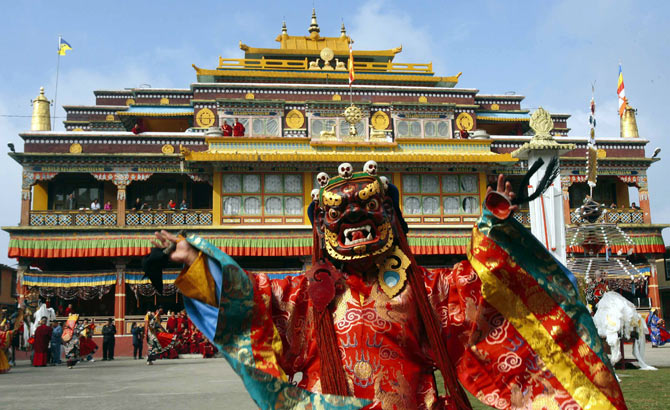
A Buddhist monk performs chaam (masked) dance inside the complex of Palchen Choeling monastery during the celebrations to mark the Gutor Chaam festival at Ralong village, about 76 km (47 miles) south from Gangtok. The festival depicts the battle between good and the evil and the ritualised destruction of the evil.

Constructed in the 16th century, by the 9th Karmapa Wangchuk Dorje, Rumtek was the primary seat of the Karma Kagyu lineage for a brief while.
However, by the time the 16th Karmapa came to Sikkim in 1959 fleeing from Tibet, the monastery was in ruins.
The Karmapa is believed to have been offered several other sites but instead chose to rebuild Rumtek, which he believed was the most auspicious of the sites.

Each of the four regions of Sikkim is distinct in its topography and culture.
While east is fertile and densely populated, the southern and western regions are where most of the monasteries are located.
The north however is harsh in its climate and topography. It does however have the kind of rugged beauty that few regions in India can boast of.
Be prepared to rough it out.
This is a scene en route to Nathu La.
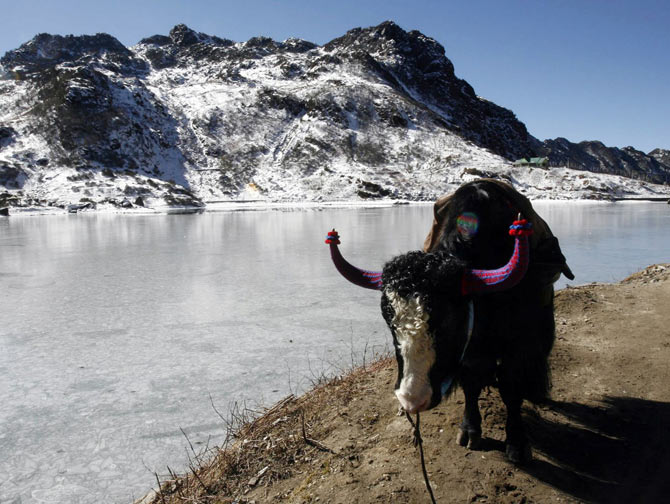
A yak stands on the banks of the frozen Tsomgo Lake near Nathu-La, 55 km north of Gangtok. The Nathu-La mountain pass, known as the old silk route, lies at an altitude of 14,200 ft. bordering between India and China and is covered with snow throughout the year.

At first the Gurudongmar Lake looks like the Pangong Tso of Ladakh made popular courtesy 3 Idiots.
Located in north Sikkim, Gurudongmar is one of the highest lakes in the world at an altitude of 17,100 feet and is but five km from the Sino-Indian border.
It is also one of the sources of River Teesta.
On the banks of the lake is a gurudwara to commemorate the visit of Guru Nanak who is said to have struck his walking out of which grew a tree.
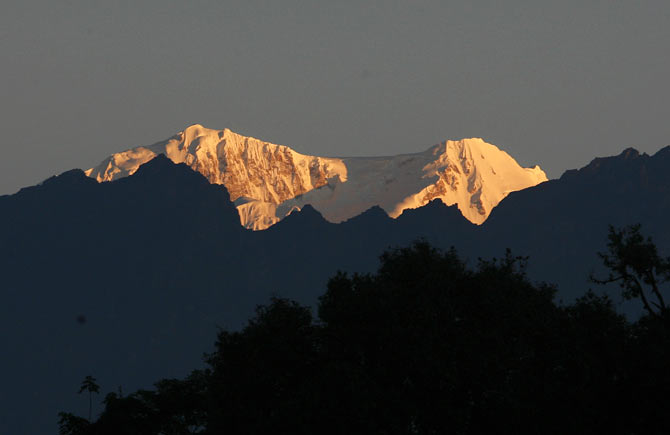
A general view of the snow covered Khangchendzonga Mountain is seen from the complex of Manelhakhing monastery in Rabangla town, about 68 km south from Gangtok
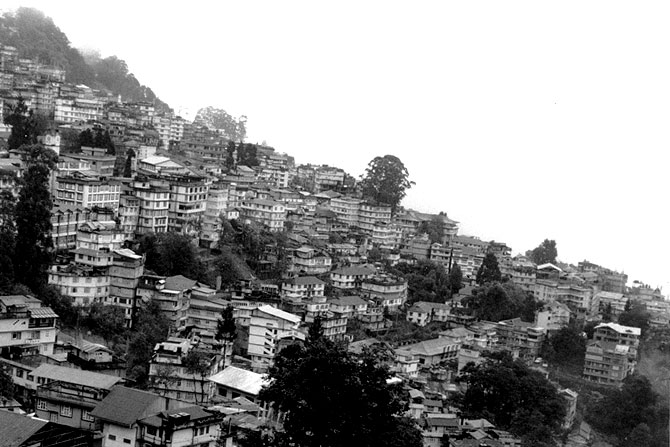
The capital of Sikkim, Gangtok is located at an altitude of 5,410 feet above sea level and is home to over lakh of people. It was a major stopover on the trade route between Lhasa in Tibet and other major cities such as Kolkata in pre-Independence India. In 1975 after Sikkim integrated with the Union of India, Gangtok became India's 22nd state capital.

Standing at 36m, located near Namchi in south Sikkim, the statue of Guru Rinpoche (Padmasambhava) the patron saint of Sikkim, is the tallest of the saint in the world and attracts devotees and tourists alike.

Seen here is a detail from the colourful gates leading to the statue of Guru Rinpoche in Namchi
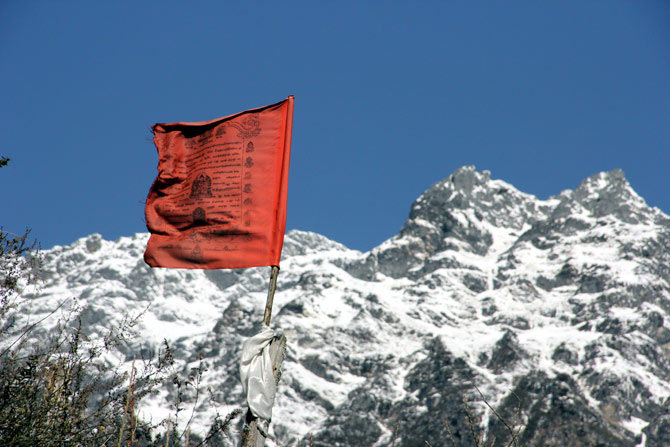
Located in northern Sikkim, the town of Lachung stands at an elevation of 9,600 feet at the confluence of two rivers -- Lachen and Lachung both tributaries of the River Teesta. Lachung translates as 'small pass' and is about 125 km from Sikkim's capital Gangtok.
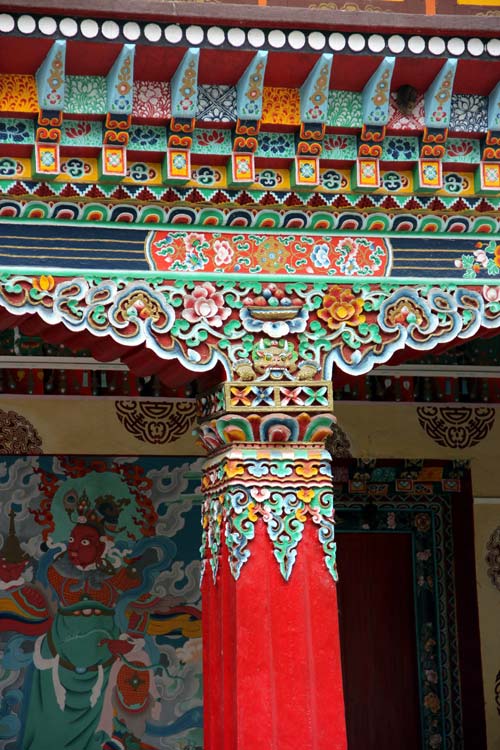
Yet another colourful detail, this time of a pillar from the Institute of Tibetology in Gangtok.
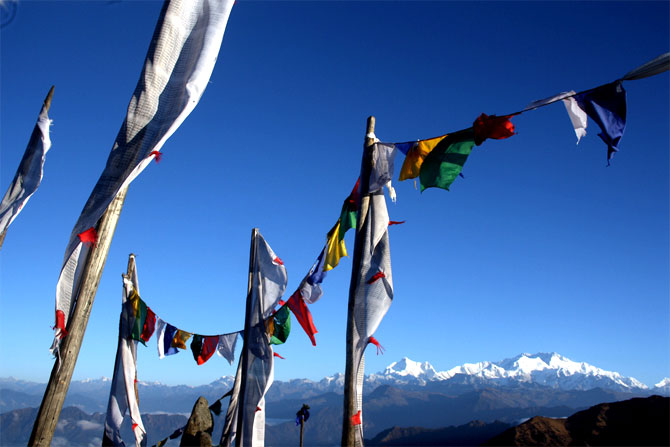
We end the this slide show with yet another view of the Kanchendzonga as prayer flags flutter over the horizon.
Have you been to Sikkim? Send us photographs of your travels to Sikkim to travelpicsga@rediffmail.com (Subject line: Sikkim Photos) and we will publish the best ones right here on Rediff.com and India Abroad.